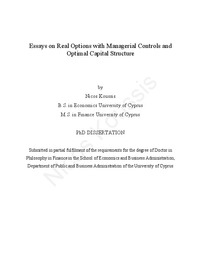Essays on real options with managerial controls and optimal capital structure

Date
2006Author
Koussis, Nicos P.Publisher
Πανεπιστήμιο Κύπρου, Σχολή Οικονομικών Επιστημών και Διοίκησης / University of Cyprus, Faculty of Economics and ManagementPlace of publication
CyprusGoogle Scholar check
Keyword(s):
Metadata
Show full item recordAbstract
Στη μελέτη αυτή επεκτείνουμε το θεωρητικό πλαίσιο ανάλυσης επενδύσεων με την μεθοδολογία προαιρετικών επιλογών ώστε να συμπεριλάβει επενδύσεις σε έρευνα και εκμάθυνση από πλευράς διοίκησης της εταιρείας και άλλες προσπάθειες βελτίωσης της αξίας της εταιρείας που αναμένεται να ενισχύσουν την αξία έχουν εντούτοις αβέβαιη έκβαση. Η ανάλυση επιτρέπει ώστε το ιστορικό των αποφάσεων να επηρεάζει τον αντίκτυπο (αναμενόμενη κερδοφορία, την διακύμανση και το κόστος) των μελλοντικών αποφάσεων. Η ανάλυση δείχνει τις βέλτιστες απόφασεις ανάμεσα σε ένα πλέγμα επιλογών καθώς επίσης και την βέλτιστη χρονική στιγμή πραγματοιήσης τους. Η ανάλυση επιτρέπει επίσης στην γρήγορη (πρόωρη) άσκηση του δικαιώματος εξάσκησης μιας επενδυτικής-διοικητικής ενέργειας καθώς και την εγκατάλειψη της επενδυτικής ευκαιρίας. Αυτό το πλαίσιο επιτρέπει την μελέτη της επίδρασης του μάρκετινγκ και της διαφήμισης ή ανασχεδιασμού του προϊόντος και επανατοποθέτησης με δράσεις βασικής έρευνας καθώς επίσης την ανάλυση επενδύσεων σε καινοτομίες. Παρουσιάζονται αναλυτικές λύσεις για πρόβληματα με χρονικά διαδοχικές επιλογές ακόμα και σε περιπτωσεις ύπαρξης απότομων μεταβολών στην αξία λόγω ανταγωνισμού και λύσεις με υπολογιστικές μεθόδους στις πιο περίπλοκες περιτώσεις. Τέλος παρουσίαζουμε ένα πλαίσιο βέλτιστης επενδυτικής πολιτικής με ταυτόχρονο προσδιορισμό της κεφαλαιακής δομής και μελετάμε την επίδραση δανειστικών περιορισμών στην αξία της εταιρείας την βέλτιστη επιλογή των επενδύσεων και σε άλλες σημαντικές μεταβλητές όπως τα δανειστικά επιτόκια. Διερευνούμε επίσης τις επιπτώσεις των δανειστικών περιορισμών στα επίπεδα φορολογιας της κυβερνησης. In this study we extend the real options framework to include managerial interacting learning and control options i.e. actions that are expected to enhance value hut have uncertain outcome. We allow the history of decisions to affect the impact (expected profitability, variance and cost) of future decisions and we show the optimal timing and optimal decision regions by also allowing early exercise and abandonment options. This framework allows the study of the effect on the value of firm 's investment opportunities of options to change the distribution of future payoffs through for example marketing research and advertisement (or product redesign or repositioning), basic research or exploration actions and product attribute or quality enhancing actions. The framework also allows the analysis of optimal timing of such actions, optimal timing of introduction of pilot projects, early development of the complete project and abandonment options. We provide analytic compound formulas for sequential options with embedded control and learning actions under the assumption that project value follows either diffusion or a jump diffusion process. We also extend the model to complex multistage problems with path dependent actions, by developing a numerical lattice based model. We illustrate the importance of this theoretical framework through applications in R&D projects and the valuation of new products. Building on recent theories based on the contingent claim approach we also model the determination of optimal investment policy (with respect to timing of investment) and the simultaneous determination of optimal capital structure and we study the impact of debt financing constraints on firm value, the optimal timing of investment and other important variables like the credit spreads. We also explore the social welfare implications of financing constraints. Finally we incorporate managerial learning and control actions in this more general framework that can be interpreted as pre-investment risky growth options (e.g. R&D, or pilot projects) using the methodology of this study and we investigate their effect on firm value and other important variables like leverage, equity and the credit spreads.
